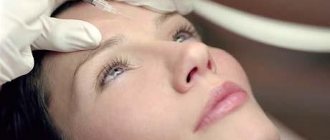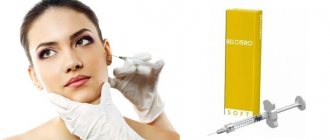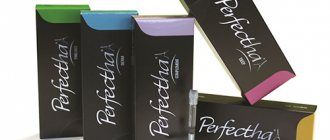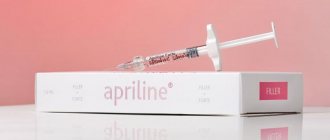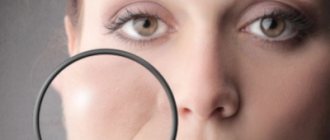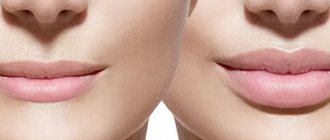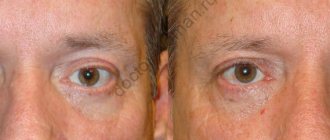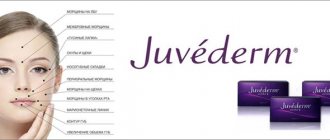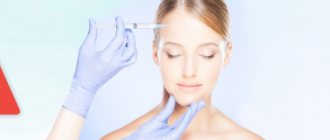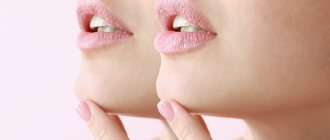Deep nasolabial folds are one of the most striking manifestations of age-related skin aging.
The formation of creases between the wings of the nose and the corners of the lips can begin as early as the age of 25. This process occurs individually for everyone. As a rule, at a young age, creases in the nasolabial folds are compensated by sufficient turgor and the level of hydration (amount of water) of the skin. Until recently, it was possible to get rid of them only with the help of a plastic surgeon and his scalpel. Surgical intervention scares off many potential patients due to its traumatic nature, blood loss, and the use of general anesthesia. Currently, there is a much more gentle method of getting rid of nasolabial folds.
One of the methods of facial rejuvenation and elimination of such creases is contour plastic surgery. This is contour plastic surgery - injection of fillers into the nasolabial folds based on hyaluronic acid.
The action of fillers is to fill the deepest layers of the dermis, which helps push the overlying tissues to the surface, which is externally manifested by smoothing out wrinkles.
With pronounced nasolabial folds, the face looks noticeably older even at a relatively young age. They give the face a sad expression despite the person’s mood.
Nasolabial folds can occur due to:
- Incorrect bite;
- Pronounced facial movements in the area of the nasolabial triangle;
- Smoking, which involves muscles on the face, which contributes to the formation of creases;
- Low skin elasticity and low amount of water in cells (due to age-related changes);
- Chubby cheeks, large amounts of fatty tissue on the face or due to hereditary reasons.
How does the procedure work?
Fillers are injected intradermally into the nasolabial folds using a thin needle. The doctor gently massages the treated area to ensure optimal distribution of the gel. To remove wrinkles in this way, it takes no more than 30 minutes, after which the patient can immediately return to their normal routine. Fillers often contain lidocaine, which helps relieve pain that occurs during the procedure.
Fillers often contain painkillers to ensure the absence of pain. After the procedure, no rehabilitation or taking any medications is required. The patient can safely return to her business.
According to the doctor’s recommendation, you should limit facial expressions for about half a day and refrain from applying makeup to the area of the nasolabial triangle. In order not to reduce the effect of therapy, you must avoid active exposure to the sun and visiting the solarium and sauna for 2-4 weeks.
Immediately after the procedure, slight tissue swelling may occur, which is a normal reaction and does not require any additional actions. After just 7-10 days, you will be able to enjoy the result of the procedure - your own rejuvenated reflection in the mirror.
The cost of facial contouring at the Doctor Grishkyan clinic in Moscow
*Prices on the website are provided as reference information and are not a public offer
Correction of the periorbital region | |
| A drug | Price |
| Teoseal Redensity II pure Sense (1ml) | 20000 |
| Glyton Professional 2-1.0ml | 16000 |
Correction of nasolabial folds, marionette wrinkles | |
| A drug | Price |
| Glyton Professional 3-1.0ml | 18000 |
| Glyton Professional 4-1.0ml | 19000 |
| Princess Filler 1ml | 18000 |
| Restylane 1.0 ml | 20000 |
| Restylane 0.5ml | 13500 |
| Restylane Perlane 1.0ml | 20000 |
| Surgiderm 24XP 0.8ml | 16000 |
Correction of the zygomatic region | |
| A drug | Price |
| Glyton Professional 4 – 0.1ml | 19000 |
| Princess Volume 1.0ml | 19000 |
| Restylane Perlane 1.0ml | 20000 |
| Surgiderm 30XP 0.8ml | 17000 |
| Radiess 0.8ml | 19500 |
| Radiesse 1.5ml | 26000 |
| Radiesse 3.0ml | 42000 |
Correction of lip volume and shape | |
| A drug | Price |
| Glyton Professional | 18000 |
| Princess Filler 1.0ml | 18000 |
| Restylane Lipp Refresh 1.0ml | 23500 |
| Surgiderm 24 XP 0.8ml | 16000 |
Moisturizing lips | |
| A drug | Price |
| Glyton Professional 2-1.0ml | 16000 |
The effect of contour plastic surgery of nasolabial folds
The result becomes clearly visible the next day after the procedure, when the swelling subsides. The obtained result can last for 1-2 years, depending on the type of filler chosen and the individual characteristics of the patient.
There are 4 groups of types of fillers
- Based on hyaluronic acid. The most frequently used. This filler is completely biocompatible, hypoallergenic and is a natural structural component of the body. Hyaluronic acid takes part in maintaining water balance and skin turgor and is eliminated from the body after about 6 months.
- Slowly dissolving. They are developed on the basis of polycaprolactone, calcium hydroxyapatite, poly-L-lactic acid. These substances dissolve in about 2-3 years.
- Non-absorbable. They are created on the basis of polymer gels. These are silicone and other substances that do not actively participate in metabolism and only mechanically fill the defect.
- Auto material. Creases are smoothed out using your own tissue (usually fat). This is the so-called lipofilling, which is actively used in plastic surgery today.
Occlusion of blood vessels and tissue necrosis after injection of hyaluronic acid filler is a serious complication. Analysis of each case is valuable, as it contributes to the collection of clinical experience. How to avoid damage to the vessel, how to understand that this is what happened, how to achieve a favorable outcome?
Fillers based on stabilized hyaluronic acid (HA) have been used in cosmetology since the early 2000s. Their injections for facial rejuvenation are one of the most popular procedures in aesthetic medicine clinics. And to date, quite a lot of experience has accumulated in the use of such drugs, their effectiveness and possible risks are known.
Blood vessel occlusion and tissue necrosis are considered rare complications. According to a large retrospective study, their number does not exceed 0.05% of the total number of adverse events (G. Eblon, 2016).
The causes of arterial or venous occlusion can be the injection of filler directly into the vein/artery, injury to the blood vessel, or external pressure on it exerted by the injected filler or the formation of edema.
Areas of the face with increased risk for injection of fillers due to the risk of vascular damage include:
- interglabellar region: frontal artery, supraorbital artery;
- nasal area: external nasal artery, angular artery;
- perioral zone: superior labial artery, inferior labial artery;
- temple area: superficial temporal artery, its posterior parietal and anterior frontal branches.
Doctors with extensive experience in performing contouring (we, for example, have been working with fillers for more than 10 years) are well aware of vascular complications. And yet, no one is immune from the risk of their occurrence. Vascular disorders after injection of fillers are possible when using a needle in dangerous areas of the face, or when introducing an excessive amount of the drug. But, in addition, we must not forget about the individual characteristics of topographic anatomy in different people.
Clinical case
Patient S., 27 years old, came to the clinic for correction of nasolabial folds.
From the medical history (general and cosmetic): somatically healthy.
Allergy history: urticaria after taking aspirin.
The patient regularly underwent cosmetic skin care procedures (peelings, masks).
According to cosmetological examination: combined skin type, Fitzpatrick phototype II.
Diagnosis: slightly pronounced nasolabial folds.
Correction: for prophylactic purposes, filler based on stabilized Teosyal Global Action HA in a volume of 1 ml was injected into the nasolabial folds with preliminary anesthesia of the treatment area (applying Emla cream under the film for 40 minutes). The injection was performed using a fan technique using a 27G needle in accordance with standard guidelines.
The procedure, which was performed by a cosmetologist with extensive experience in the field of injection contouring, went smoothly; the patient did not have any complaints during its implementation or immediately after completion.
5 hours after filler injection.
Development of complications
5 hours after the filler injection, the patient noticed bluish spots on her nose, took photographs of them and sent them to the doctor. We urgently called the patient to the clinic. During examination, it was noted that in the area of the back and wings of the nose there was a change in skin color in the form of merging pale purple spots with a distinct border and a pronounced vascular pattern.
A consultation was held with a dermatocosmetologist, certified trainer in injection contouring, K. A. Filippova. She confirmed our suspicion regarding vessel occlusion during filler injection.
Diagnosis: ischemia of the soft tissues of the nasal area.
Treatment: an enzyme preparation with a proteolytic effect, Longidase, was immediately introduced (diluted 3000 IU bottle into 2.5 ml of physiological solution): into the area of the nasolabial folds - subcutaneously and intradermally, into the nasal area - intradermally, only about 1 ml of solution . A massage of the ischemic area was also performed.
Result: clinically significant improvement with almost complete restoration of normal skin color.
Immediately after the first injection of hyaluronidase.
Further appointments:
– taking a drug with anticoagulant, antithrombotic, angioprotective and profibrinolytic effects.
Due to an allergy to aspirin, Vessel DUE F 250LE was prescribed, 1 capsule per day;
– for prevention:
a) herpetic infection - Valtrex, 500 mg once a day;
b) infection due to ischemia - broad-spectrum antibiotic Amoxiclav, 500 mg 2 times a day for 7 days;
c) dysbacteriosis – “Linex”, 1 capsule 3 times a day for 7 days.
1 day after the injection of the filler and the first Longidase injection.
One day after the filler injection, the patient came for a follow-up examination. Clinically, no deterioration of the tissue condition of the treatment area was noted.
The patient said that she had not taken antibiotics and was against taking them in the future. Since there was no negative dynamics, it was decided to abandon the use of antibiotics, as well as the repeated injection of Longidase.
Three days after the injection of the filler, the patient went to the clinic due to a deterioration in her condition. Upon examination, we diagnosed superficial necrosis of the tissues of the nasal wing on the left (photo 7).
Treatment: a second injection of Longidase was immediately performed.
Next, antibiotic therapy was prescribed and topical application of Triderm ointment 2 times a day until the complication resolved.
Result: with the prescribed therapy, healing in the area of the wing of the nose proceeded safely within 7 days, without scar formation (photo 8).
3 days after filler injection.
7 days after re-administration of Longidase.
Clinical case discussion and conclusions
When analyzing the resulting complication, it is first necessary to pay attention to the blood supply to the external nose and nasolabial area (Fig. 1) (R. Radlanski, K. Wesker, 2014). From the point of view of surgical anatomy, two circumstances are of greatest importance.
Firstly, the branches of the corresponding paired arteries anastomose with each other at the level of the dorsum of the nose, forming a wide anastomotic network. Therefore, slight compression or occlusion of the branches of a. Lateralisnasi (branches of a. angularis in the area of the wing of the nose) does not lead to disruption of the blood supply to the skin (if other sources of blood supply are preserved). In our case, there is a slight disturbance of the blood supply in the nasal area, more pronounced on the left, and a favorable outcome of the complication (which is determined by the anatomical features of the blood supply to this area).
Secondly, the superior labial artery (a. Labialis superior) departs from the angular artery in the area of the nasolabial fold, which also poses a risk of developing vascular complications (the likelihood of necrosis of the soft tissues of the upper lip when the artery is compressed by filler or when the artery is occluded by filler).
It must be remembered that there is an atypical structure of blood vessels (low/high origin of branches from the angular artery, duplication of arteries).
In our case, most likely, the location of the branches from the angular artery to the soft tissues of the nasal wing was too superficial and low. Probably, on the right there was compression of the vessels by the filler, and on the left there was an embolism of small vessels. Therefore, only a change in color was observed on the right, while necrosis began on the left. However, we injected Teosyal Global Action, a loose filler, shallowly and in small portions. Therefore, here we can talk about the structural features of the blood vessels in this patient.
In our opinion, the case discussed is quite instructive. What conclusions did we come to, what did we do right, where did we go wrong?
- There was no need to use a needle: to make filler injections into the nasolabial fold as safe and minimally traumatic as possible, they should be performed only with a cannula!
- The doctor's knowledge of the location of nerves, arteries and veins will help avoid injecting the drug into the vessels of the face, but does not guarantee this in all cases.
- You should always listen to the complaints of your patients during and after the procedure. A change in skin color immediately after filler injection indicates vascular ischemia. Symptoms of arterial or venous occlusion, which can lead to skin necrosis, include discoloration or darkening of the skin (to a blue-gray hue), ecchymosis, reticular erythema, and severe pain at the injection site. In our case, changes in the color of the skin in the nose area did not appear immediately, there was no acute pain during the procedure, the procedure was carried out as standard. A successful outcome of the complication was achieved due to the timely initiation of treatment.
- If this is the first time in your practice and you are at a loss or don’t know what to do, you need to consult with your colleagues (if possible).
- In the office of a cosmetologist who performs filler injections, there must be a hyaluronidase preparation and, if possible, nitroglycerin paste to stimulate blood flow (unfortunately, we did not have it).
- It is necessary to periodically attend training events in order to once again repeat the anatomy of the face, learn as much as possible about complications and possible ways to eliminate them.
Conclusion
I would like to remind you once again that in case of vascular occlusion or advancing necrosis, the main direction of treatment is to stimulate blood flow in the affected area, as well as relieve inflammation. The following methods can be used for this:
- immediate application of a warm compress;
- massage the affected area to dilate blood vessels and disperse the injected drug;
- in case of injection of hyaluronic acid fillers, a mandatory injection of hyaluronidase is required. It is better to use large doses of this enzyme than to administer insufficient amounts (D. Jones, 2011);
- taking aspirin or other anticoagulants;
- the use of external drugs that stimulate vasodilation (nitroglycerin paste);
- injection of corticosteroids (prednisolone at a dose of 20 to 60 mg over several days to reduce the inflammatory component of the injury);
- taking antibiotics;
- taking antiviral drugs.
The main thing is to remember that if a change in skin color occurs in the correction area, if the patient feels pain and discomfort, the injection must be stopped immediately.
Many authors recommend performing an aspiration test when inserting the needle to ensure that it has not entered the vessel: if there is no sign of blood when pulling the syringe plunger towards itself, slowly inject the filler and observe the surrounding skin for pallor, vascular hyperemia, reticular erythema or the appearance of violet /dark/gray-blue hue. However, this advice is of little use in practice. Firstly, there are many injections and it is not possible to do an aspiration test every time. Secondly, according to other authors, if there is filler in the needle (especially dense), this test does not work.
If you suspect that a vascular disorder occurred during the injection of filler, then leave the patient in the clinic under your supervision for at least an hour: it is always better to examine him again and make sure that there are no negative consequences of your actions.
Elena Belyanina, Ph.D., surgeon, head. Department of Laser Surgery; Alla Krivonosova, Ph.D., dermatologist, cosmetologist of the laser surgery department of the Federal State Institution “Treatment and Rehabilitation”), Moscow
The best fillers for nasolabial folds based on hyaluronic acid
- Princess Filler and Volume
- Juvederm Ultra 3 and 4
- Surgiderm 24XP
- Restylane Perlane
Pros of the procedure
The advantage of introducing fillers into the nasolabial folds is the undeniable effectiveness of the method, non-traumatic nature, and a quick period of complete recovery. The procedure gives an expressive rejuvenating effect, reduces the severity of deep wrinkles and folds. The drugs used are based on non-animal hyaluronic acid and do not cause allergic reactions.
Contraindications include pregnancy and lactation, cancer, chronic diseases of internal organs in the acute stage or decompensation, acute infectious processes, inflammatory skin diseases, autoimmune processes.
Cost of the procedure
The price of contouring of nasolabial folds is largely determined by the filler that is used for this. The cost of the filler is affected by:
- The type of specific drug and manufacturer, which determines the quality and duration of the effect;
- Quantity is the volume determined by the cosmetologist to eliminate a cosmetic defect.
It is important not to save money here, because only proven and high-quality fillers will bring you the desired result. Our clinic works with products from leading global manufacturers. Therefore, you can be absolutely confident in the safety and quality of the procedures offered.
Removing nasolabial folds - price in Moscow at CTTC. Find out the full price list for services
Registration for the procedure
Do you want to remove nasolabial folds? The price of the procedure at the Tatyana Tsimbalenko Trichology Center is affordable for a wide range of patients. You can familiarize yourself with the cost of services in the corresponding section of the site. We work every day, seven days a week. You can make an appointment at a convenient time by phone or through the website.
Correction of nasolabial folds with fillers
To get rid of nasolabial folds, cosmetologists use fillers. These are dense gels that add missing volume and smooth out wrinkles. Unlike plastic surgery, the procedure is performed through injections and eliminates surgery. This reduces the risk of complications and shortens the duration of the rehabilitation period after the procedure several times.
Contour plastic surgery with fillers can be combined with other procedures, for example, botulinum therapy. This aspect is relevant for girls with active facial activity, for whom monotherapy is no longer enough to achieve results.
Photos before and after
Cost of procedures
Injection cosmetology – Contour plastic surgery
| Name | price, rub. |
| Initial appointment with a cosmetologist, consultation is free, subject to completion of procedures on the day of treatment | 1000 0 |
| ART Filler Fine Lines (1 ml.) | 14 000 |
| ART Filler Universal (1.2 ml.) | 16 000 |
| ART Filler Volume (1.2 ml.) | 18 000 |
| Juvederm 3 (1 ml.) | 15 000 |
| Juvederm 4 (1 ml.) | 15 800 |
| Juvederm ULTRA SMILE (0.55 ml.) | 11 500 |
| Juvederm Volbella (1 ml.) | 16 830 |
| Juvederm Voluma (1 ml.) | 18 200 |
| Juvederm Volite (1 ml.) | 16 500 |
| Juvederm Volift (1 ml.) | 17 200 |
| Juvederm Volift Retouch (0.55 ml.) | 12 100 |
| Belotero Soft (1 ml.) | 12 900 |
| Belotero Balance (1 ml.) | 13 500 |
| Belotero Intense (1 ml.) | 14 200 |
| Belotero Volume (1 ml.) | 16 500 |
| Belotero Lips Contour (0.6 ml.) | 11 500 |
| Stylage S (1 ml.) | 10 350 |
| Stylage M (1 ml.) | 12 350 |
| Stylage lips (1 ml.) | 12 350 |
| Stylage L (1 ml.) | 13 350 |
| Stylage XL (1 ml.) | 15 350 |
| Hyaluform Soft (0.8 ml.) | 9 500 |
| Hyaluform Normal (1 ml.) | 11 000 |
| Hyaluform Deep (0.8 ml.) | 11 000 |
| Hyaluform Sub Derm (1 ml.) | 11 900 |
| Hyaluform Sub Derm (2 ml.) | 19 000 |
| Hyaluform Intimo (1 ml.) | 13 500 |
| Radiesse (1.5 ml.) | 20 300 |
| Radiesse (3 ml.) | 32 000 |
| AestheFill® (20 ml.) | 40 500 |
*Promotion: when purchasing more than one syringe for one procedure, there is a 10% discount on the 2nd syringe.
See also:
Contour plastic surgery of the nasolacrimal groove
Types of fillers
The history of fillers for injection contouring began back in 1940 with silicone-based fillers. However, after several decades, I had to deal with the unpleasant consequences of using such gels: chronic inflammation developed, fillers moved unpredictably under the skin, leading to facial deformation. Soon, cosmetologists stopped using silicone gels in most countries - they were replaced by fillers based on hyaluronic acid of animal or synthetic origin, collagen, calcium hydroxyapatite or polylactic acid.
Today, there are a variety of drugs on the market that differ in the active ingredient, cost, duration of action, the presence of pain-relieving components, and additional effects (for example, the ability to moisturize the skin or stimulate collagen production). Hyaluronic acid fillers are the most popular, but they are not the only option available. Some people have increased production of the enzyme hyaluronidase, which breaks down hyaluronate. Fillers based on calcium hydroxyapatite are suitable for them.
The final choice of drug is made by the doctor after an in-person examination. In this case, many different factors are taken into account, from the condition of the skin and the body as a whole to the effect that should be obtained. It is not recommended to select a drug on your own, following the example of friends or advertising - in this matter you should trust a cosmetologist.
Features of the procedure
Placement of hyaluronic fillers into the nasolabial lips is carried out as follows:
- Preparation. The cosmetologist selects a suitable drug, outlines the location and depth of administration. Determines how much gel will be needed to fill creases.
- Anesthesia. To minimize discomfort, the doctor will apply an anesthetic cream. After the time specified in the instructions, the skin is cleansed and disinfected.
- Introduction of the gel. The gel is injected under the skin to a depth of 5 mm using a very thin needle. To fill the cavities evenly, the cosmetologist has to give 2-3 injections on each side.
- Distribution of the drug. After performing the injections, the doctor distributes the product using massaging movements. The procedure is completely painless.
- Skin cleansing, consultation. The cosmetologist removes the protruding droplets of blood with sterile cotton wool, cleanses and disinfects the skin. Gives advice on care during rehabilitation.
The effect of using fillers is noticeable immediately after the procedure: the skin is smoothed, the face looks younger and healthier. As for the final result, you can expect it within 5-20 days. During this time, the drug will be evenly distributed under the skin, the active ingredients will begin to moisturize and nourish the epidermis, and side effects (wounds, swelling, bruises, red spots) will disappear.
Why choose "MariLove"
A medical doctor will help you remove nasolabial folds with filler in Moscow. Reasons why clients choose us:
- a wide range of cosmetology services;
- high-quality drugs produced in the USA, Austria, France;
- qualified cosmetologists with extensive experience;
- the use of anesthetics to make the procedures comfortable and painless;
- careful maintenance of sterility;
- affordable prices, promotions, promotional codes for discounts.
To fill nasolabial folds with filler, sign up for the procedure online or by phone. Customer reviews and “before and after” photos can be found on the website. Preliminary consultation with a cosmetologist is free.
How to choose a drug
The medical department presents drugs from the best foreign manufacturers. A cosmetologist will help answer the question of which filler is better by listening to the patient’s complaints and becoming familiar with the characteristics of his body. Most often, hyaluronic acid preparations are used for contouring - they are safe, effective and affordable.
Cost of drugs
The cost of fillers varies from 8 to 12 thousand rubles per 1 ml. The total cost of contour plastic surgery depends on the country of manufacture of the drug and its quantity. The deeper the crease, the more money will be required to restore the original volume.
Correction stages
- Any cosmetic procedure begins with an examination and consultation with a doctor. The doctor collects anamnesis and develops an individual treatment plan;
- The next stage is skin cleansing, makeup removal;
- A cream or gel with an anesthetic effect is applied to the face. It starts working within 20 minutes;
- The doctor treats the injection area with an antiseptic, removing any remaining cream, and begins introducing filler according to an individual scheme;
- Using gentle massage movements, the doctor distributes the drug under the skin. After this, under no circumstances should you massage your face yourself. It is also better to avoid active facial expressions for 24 hours until the gel “sets up.” It is better not to touch or disturb the treated areas for a week to avoid premature degradation or migration of the gel;
- At the end of the procedure, a refreshing, soothing mask is applied to the skin. The product relieves swelling, soothes the skin, and promotes rapid healing of punctures.
To eliminate nasolabial folds, one single procedure is enough. The result lasts for a long time, but in the future (usually after a year and a half), when the fillers are completely absorbed, you can return to the clinic to smooth out wrinkles.
Like other injection procedures, correction can only be carried out by a qualified cosmetologist in a medical facility. You should not try to save money by entrusting the procedure to an insufficiently experienced specialist at home. In this case, there is a high risk of complications - inflammation, allergic reactions, swelling or deformation.
